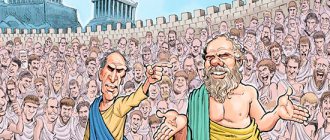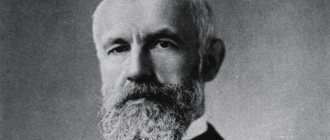Greetings, friends!
Surely you have come across people who manage to convincingly defend their point of view, even when they are obviously wrong. In Ancient Greece, there was a whole philosophical movement, within the framework of which those who could prove that they were right while being wrong were considered truly wise people. This movement was called sophistry, and its supporters were called sophists. Today we will look in detail at what sophistry is, learn the history of its appearance and development, and consider examples of sophistry. Let's begin!
What is sophistry?
Sophistry is one of the trends in ancient Greek philosophy that arose in the 5th century BC. The Sophists have long been among the most revered philosophers, considered sages by their contemporaries. They were eloquent, thanks to which they could win almost any dispute. But over time, the attitude towards the sophists changed. If initially they were considered sages, then later they began to be treated as resourceful and dishonest demagogues.
Classical sophistry as a philosophical doctrine did not exist for long - in the 5th and 4th centuries BC. Later, new sophistic movements arose, but they also quickly ceased to exist. Today, the term "sophistry" is used to refer to a special form of argumentation that misleads by making points that appear logical. Such theses are called “sophisms.” They may use logical errors, polysemy of some terms, substitution of concepts, accepting false statements as true, non-obvious violation of the laws of logic, and other techniques.
In modern philosophy, sophistry is the deliberate use of sophistry to mislead people. This technique can be quite effective. The logical error embedded in a statement is often so well disguised that it is difficult to find without deep analysis. Therefore, the use of sophisms is condemned and subject to well-founded criticism.
Intellectual and affective reasons
A developed intellectual person has the ability to monitor not only his own speech, but also every argument of his interlocutor, while paying attention to the arguments given by the interlocutor. Such a person is distinguished by a greater attention span, the ability to seek answers to unknown questions instead of following memorized patterns, as well as a large active vocabulary, with the help of which thoughts are expressed most accurately.
The amount of knowledge is also important. The skillful use of this type of violation, such as sophistry in mathematics, is inaccessible to an illiterate and non-developing person.
These include fear of consequences, due to which a person is not able to confidently express his point of view and present worthy arguments. When talking about a person’s emotional weaknesses, we must not forget about the hope of finding confirmation of one’s views on life in any information received. For a humanist, mathematical sophisms can become a problem.
History of sophistry
This philosophical movement arose in the 5th century BC. It was created by philosophers who called themselves sophists. Back then this word had a positive connotation. The Sophists themselves positioned themselves as teachers of wisdom. They taught other people philosophy, logic and, of course, rhetorical techniques. Very quickly they realized that the ability to prove any idea replaces real knowledge, so it was this skill that they taught their students.
In fact, the activities of the sophists quickly came down to the search for the most effective methods of arguing, usually dishonest. These techniques consisted of substitution of concepts, deliberate concealment of logical errors, and even psychological pressure. And in order to defend their right to such an approach, the sophists created a special philosophical ideology, within the framework of which it was argued that objective truth cannot exist. And if a person is able to prove a certain statement, it can be considered true.
The history of sophistry consists of two periods, which are conventionally called “senior” sophistry and “younger” sophistry. The most famous representatives of the “older” sophistry are Protagoras, Gorgias, Hippias and Antiphon. Among the “younger” sophists, the most famous are Critias, Alcidamas (Alcidamas), Callicles, Thrasymachus and Lycophron. Almost all the sophists were very rich people, since the rich willingly took wisdom lessons from them. At the same time, they were treated unkindly in society (they even got along poorly with each other and often got into arguments).
Logical paradox "Crocodile"
The crocodile snatched the child from an Egyptian woman, but, taking pity on the woman, after her plea, he put forward conditions: if she guessed whether he would return the child to her or not, then he, accordingly, would give it or not give it back. After these words, the mother thought about it and said that he would not give her the child.
To this the crocodile replied: you will not get the child, because if what you say is true, I cannot give you the child, because if I give it, your words will no longer be true. And if this is not true, I cannot return the child by agreement.
After which the mother disputed his words, saying that in any case he should give her the child. The words were justified by the following arguments: if the answer was true, then according to the contract the crocodile had to return what was taken away, and otherwise he was also obliged to give up the child, because refusal would mean that the mother’s words were true, and this again obliges him to return the baby.
Examples of sophistry
As we have already found out, sophistry is the deliberate misleading of another person through manipulation of wording. One of the classic examples is the so-called “Evatlov sophistry.” This case has been preserved in history due to the fact that the sophistic technique was used against Protagoras (one of the most famous sophists) by his own student.
Protagoras agreed to give lessons to Euathlus under unusual conditions: he would pay him for his tuition only if he won his first trial. After finishing his studies, Evatl did not take up any business, and therefore refused to pay. The indignant Protagoras threatened Euathlus with court. However, if Evatl wins in court, he would not pay due to the court decision, and if he loses, he would not pay, because still haven't won a single case. Thus, Evatl outwitted the teacher, because regardless of the court’s decision, he would have been right and could, on completely legal grounds, not pay for tuition.
To better understand what sophistry is, it is advisable to look at other examples. There are a huge number of such statements that look logical, but are based on false facts. Let's look at a few popular sophisms:
- A passenger is traveling on a train. The train is traveling to Moscow. This means that the passenger is going to Moscow (sounds quite logical if you ignore the fact that the passenger can get off long before the final station).
- If two halves of different objects are equal, then the objects themselves are equal. Two glasses half filled with water are equal. Therefore, an empty glass is equal to a full one.
- If the medicine is useful, then it must be taken constantly. But they don’t take it all the time, because the medicine is harmful for a healthy person. Then why does a sick person take it if he is already feeling bad?
The well-known logical reasoning that the crocodile is longer than the green one is also built on a sophistic principle. And even in such an exact science as mathematics there is a place for sophisms. Surely you have at least once seen the “proof” that 2 x 2 = 5. Typically, such mathematical tricks are based on the fact that at some stage of the calculation an implicit division by zero occurs.
There is also an example about an athlete who supposedly will never catch up with a turtle. However, not everyone notices that at each iteration the frame of reference is deliberately chosen so as to never reach the point where the athlete actually overtakes the turtle.
By the way, to use sophistry it is not necessary to have a high IQ, any special skills, or even cunning. You can do it even without knowledge of logic. Surely you have at least once encountered such a phenomenon as cyberbullying (what is it?). Usually a more aggressive person puts pressure on his opponent with phrases like “Give me your address if you are so brave.” And it even sounds logical: if a person is brave, then why doesn’t he give his address?
Socrates
The outstanding ancient Greek philosopher Socrates is usually considered to be among the sophists, but his teaching differed in many ways from the teaching of the sophists:
- the main method of Socratic philosophy is “maieutics” - the search for truth through a chain of logical conclusions; The task of a philosopher is not to give a person a ready-made truth, but to help him come to this truth himself;
- the truth was achieved through dialogue or discussion in the form of question and answer. By the end of the dialogue, a definition of truth should have been achieved as not contradicting itself. This was manifested in the fact that the opponent came to contradict himself and the original theses, which Socrates drew attention to. This approach was called dialectics.
Peculiarities of the teachings of the “senior” sophists
The first sophists sought knowledge. At the same time, they started from the fact that the knowledge accumulated by mankind is mostly erroneous. Today it is their teaching that is talked about first of all in order to explain what sophistry is. They explored the problems of all the sciences that existed at that time and doubted established religious beliefs. In fact, the “senior” sophists were initially skeptics who subjected absolutely everything to critical rethinking. They didn’t deny anything, they simply voiced the pros and cons.
All “senior” sophists can be divided into three groups:
- Speakers
. Representatives of this group had a perfect command of the language and were able to beautifully argue their point of view. - Erists
. These were debaters who participated in an argument for the sake of an argument. They sought to win the controversy at any cost, which caused universal condemnation. - Politicians
. These sophists used their skills and knowledge to achieve political goals.
Among the senior sophists, Protagoras is the most famous. He was, of course, a very smart and wise philosopher for his time. It is believed that it is from him that the main thesis of sophistry comes that man is the measure of all things , and the essence of all phenomena is determined by how a person perceives them.
Protagoras emphasized the relativity of truths, denying their absoluteness. It is also believed that it was this philosopher who first put forward the idea of a democratic society. He also talked a lot about how, with the help of correct argumentation, lawlessness can be defeated.
Protagoras' most famous student was Socrates, who stood out for opposing his teacher and other sophists. Instead of rejecting the existence of absolute truth, he believed that such truth exists, and it is determined by the divine essence.
Another famous "senior" sophist was Gorgias. He believes that it was he who created rhetoric. His statement is known that one action can be considered both bad and good - it all depends on the point of view. Also preserved in history is the name of Hippias, who became famous for his eloquence. His lessons were highly valued, and he managed to get rich, while maintaining, unlike most sophists, his good name.
Logical paradoxes
Sophisms and paradoxes are two different concepts. A paradox is a proposition that can prove that the proposition is both false and true at the same time. This phenomenon is divided into 2 types: aporia and antinomy. The first involves the appearance of a conclusion that contradicts experience. An example is the paradox formulated by Zeno: the fleet-footed Achilles is not able to catch up with the tortoise, since with each subsequent step it will move away from him some distance, not allowing him to catch up with himself, because the process of dividing a segment of the path is endless.
Antinomy is a paradox that presupposes the existence of two mutually exclusive judgments that are simultaneously true. The phrase “I am lying” can be either true or false, but if it is true, then the person uttering it is telling the truth and is not considered a liar, although the phrase implies the opposite. There are interesting logical paradoxes and sophisms, some of which will be described below.
Peculiarities of the teachings of the “younger” sophists
This part of the history of sophistry has not been preserved very well, so there is little reliable information about the “younger” sophists. Famous representatives of the movement were Lycophron, Alcidamas, Thrasymachus, Callicles and Critias. Their ideas were based on the following theses:
- there should be no barrier between social classes;
- elite is an artificial concept, an invention of a group of people;
- nature created every person free, there should be no slavery.
The younger sophists talked a lot about ethics and morality, as well as about freedom and rights. In particular, Thrasymachus supported the ideas of democracy, extolled atheism and criticized religions.
Violations of logic in mathematics
Usually mathematical sophisms prove the equality of unequal numbers or arithmetic expressions. One of the simplest examples is a comparison of five and one. If you subtract 3 from 5, you get 2. When you subtract 3 from 1, you get -2. When both obtained numbers are squared, we get the same result. Thus, the primary sources of these operations are equal, 5=1.
Mathematical problems-sophisms are most often born due to the transformation of initial numbers (for example, squaring). As a result, it turns out that the results of these transformations are equal, from which a conclusion is drawn about the equality of the original data.
Parable about the railway
An example of this type of violation of logic, such as economic sophisms, is the theory of building a railway from one large city to another. A special feature of this route was the gap at a small station between two points that were connected by the road. This gap, from an economic point of view, would help small towns by bringing in money from people passing through. But there is more than one settlement on the route of two large cities, that is, there must be many gaps in the railway to extract maximum profit. This means building a railroad that doesn't actually exist.
Arguments in the discussion
The arguments people give during discussions are divided into objective and incorrect. The former are aimed at resolving a problem situation and finding the correct answer, while the latter pursue the goal of winning the argument and nothing more.
The first type of incorrect arguments can be considered an argument to the personality of the person with whom the dispute is being waged, drawing attention to his character traits, appearance, beliefs, etc. Thanks to this approach, the arguing person influences the emotions of the interlocutor, thereby killing the rational principle in him. There are also arguments to authority, power, profit, vanity, loyalty, ignorance and common sense.
So, sophistry - what is it? A technique that helps in a dispute, or meaningless reasoning that does not give any answer and therefore has no value? Both.
Reason, obstacle
Sophisms, examples of which are discussed by Frederic Bastiat, have become very famous, and especially the violation of the logic “reason, obstacle”. Primitive man had practically nothing and in order to get something, he had to overcome many obstacles. Even a simple example of overcoming a distance shows that it will be very difficult for an individual to independently overcome all the barriers that stand in the way of any single traveler. But in modern society, solving problems of overcoming obstacles is carried out by people specialized in such occupations. Moreover, these obstacles turned into a way for them to earn money, that is, to get rich.
Each new obstacle created gives work to many people, it follows that there must be obstacles in order for society and each individual to enrich themselves. So which conclusion is correct? Is the obstacle or its removal a benefit to humanity?
Problems with broken logic
Why does the block remain at rest when a 1 kg weight is placed on it? After all, in this case the force of gravity acts on it, doesn’t this contradict Newton’s first law? The next task is thread tension. If you fasten a flexible thread at one end, applying a force F to the second, then the tension in each section will become equal to F. But, since it consists of an infinite number of points, the force applied to the entire body will be equal to an infinitely large value. But according to experience, this cannot be in principle. Mathematical sophisms, examples with and without answers can be found in the book authored by A.G. and D.A. Madeira.
Action and reaction. If Newton's third law is true, then no matter what force is applied to the body, the reaction will hold it in place and prevent it from moving.
A plane mirror swaps the right and left sides of the object it displays, then why don't the top and bottom change?











